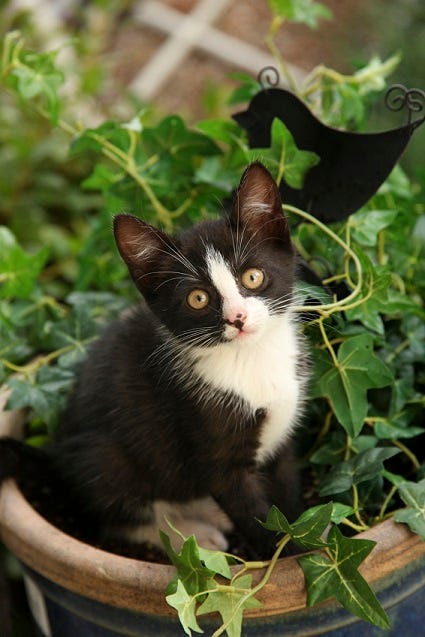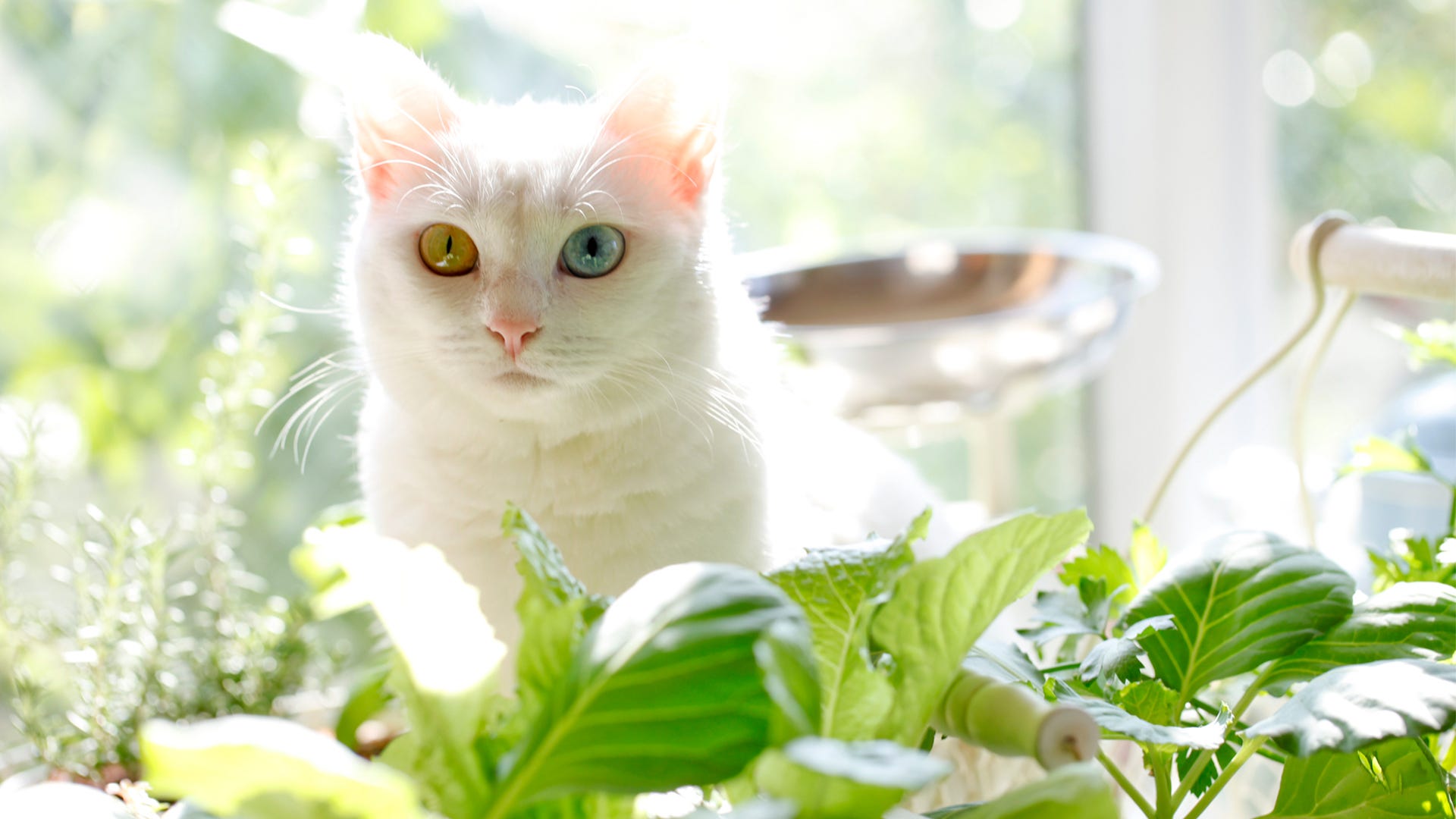Whether our cats want to taste, hide in, knock over or go to the bathroom on our house plants, they should be kept away from them for a variety of reasons. In addition to avoiding a mess or ending up with damaged or even destroyed plants and flowers, there exist more serious concerns should your cat ingest parts of the plant. Avoid health problems in your cat, from minor digestive issues to severe poisoning, while safeguarding your plants at the same time.
Your Responsibility
Once we invited cats to share our homes with us, we took it upon ourselves to provide for all their needs. Whether due to fears that they will encounter an ill-fated end on our busy roads or that they will simply run away and not return, cats are increasingly being kept as indoor-only pets. This means that whenever they have a craving – whether it is hunger, voiding, curiosity or just plain mischievousness – the only place where they can satisfy it is within your walls. And it doesn’t matter if you’ve set up a specific space for each of their desires; they will often ignore your solutions and seek out their own. Willful, aren’t they?
Something Missing in Their Diet?
When cats lived “in the wild” (which even centuries ago was rarely far from human habitation), they fed themselves – I know, it’s hard to believe these pampered little layabouts could have once had the wherewithal to take care of themselves, but they did! And they weren’t as finicky about what they ate either.
What they invariably ate was meat, and pet food manufacturers respond to cats’ carnivorous nature by offering cat food that focuses on protein derived from meat sources. Cats did get plant matter to a small degree from inside the animals that they consumed, and perhaps this missing element is what drives them to sample our house plants.

But unlike the already-digested vegetation found in the stomachs of their prey, when cats eat plants directly, they usually regurgitate them afterward. This is because they lack the ability to break down plant matter all the way. This alone is not cause for concern, as cats will sometimes do this to clear their digestive tract. It becomes serious if you suspect the cat has been nibbling on one of the many plants listed as being highly toxic to felines.
Poisonous Plants for Cats
Among the many common houseplants poisonous to cats, one of the most dangerous is the lily. Certain species of “true lilies” could lead to kidney failure if ingested. The other top five plants that are lethally dangerous to cats are:
- Azalea
- Cyclamen
- Mistletoe
- Oleander
- Rhododendron
The Humane Society has an extensive list of plants that are hazardous to pets, detailing which parts of the plant are toxic. For a list that is more specific to cats only, see the list on the Cat Fanciers’ Association’s website. And 1st in Flowers offers an interactive list that shows pictures of the plants for easy identification and includes what health risk each one poses for your feline.
If you are sure your cat has been poisoned, proceed immediately to your vet, bringing a portion of the plant with you (and a sample of the vomit if there was any). If uncertain, hotlines are available to assist you. Call the American Association of Poison Control Centers at 1-800-222-1222 or the Pet Poison Helpline (which charges a fee of $49 per incident) at 1-855-764-7661. Pay particular attention if your pet is exhibiting any of these signs:
- Vomiting
- Drooling
- Increase in drinking and/or decrease in eating
- Diarrhea and/or urinating more than usual
- Change in breathing and/or heartbeat
Non-Fatal Plant Issues
Even if you have adorned your home with a pet-friendly assortment of house plants, you are still likely to have problems with your feline companion. Whether they rub up against a pot too heavily or do one of their famous paw pats to knock something off its perch, you may come home to find broken planters, soil scattered all over the floor – or on your carpet! – and a slowly dying plant.
Even secure planters may still be raided, their plants attacked and their soil dug into. And then there’s the inevitable vomit that must be cleaned up – and found first! – if your cat ate some of it. There’s nothing like walking into a room barefoot, only to discover that you’ve unintentionally located the spot where your cat retreats to deposit its indigestibles.
Another thing cats tend to do with plants that strike their fancy is to use their pot as a litter box. According to the National Gardening Association, “cat urine can burn the roots of your plants.” It’s as if cats are getting back at plants for the serious harm that some do to them!
How to Keep Cats Out of Plants
 Perhaps instead of wondering how to keep cats away from your plants, you should consider keeping the plants away from where the cat can reach. If it is not an option to hang your plants or place them in areas that Tabby is unable to get to or prohibited from accessing, you will have to find a way to make the plant or its location unappealing. (And if your kitties keep avoiding their litter box, make sure that they always have fresh cat litter inside or they will continue to find untraditional places to do their business.)
Perhaps instead of wondering how to keep cats away from your plants, you should consider keeping the plants away from where the cat can reach. If it is not an option to hang your plants or place them in areas that Tabby is unable to get to or prohibited from accessing, you will have to find a way to make the plant or its location unappealing. (And if your kitties keep avoiding their litter box, make sure that they always have fresh cat litter inside or they will continue to find untraditional places to do their business.)
Try to offend your cats’ sense of smell by applying Critter Ridder® in your planters, which is available in spray or granular form. In addition to this, present a tactile surface that will make stepping on the soil uncomfortable for delicate paws by placing a length of aluminum foil over the soil.
Or add rocks, pine cones or toothpicks sticking out of the soil. You can also try to tempt your cats away by giving them something else that will act as a greater lure for them. Give them their own plant, and make it one that they will enjoy, such as cat grass or catnip. These are edible for your cat, and stores offer them specifically for this purpose.
Suggestions for Pet Safe Plants
Whether your cat has yet to show an interest in eating or desecrating your plants or not, why not be safe and stick to ones that you know won’t harm your little companion. Here are some cat-friendly plants for your home that will give you peace of mind:
- African violet
- Ferns
- Orchids
- Spider plant
- Succulents
Many of the tricks mentioned above also work for outdoor gardens that are visited by strays. Let us know if you have experience with these or other plants safe for cats or additional advice for how to stop a cat from peeing where it shouldn’t in the comments section below. Join us on Facebook and add to the discussion. Plus, don’t forget to subscribe to our eNewsletter for exclusive updates and more great resources!





